[vc_row][vc_column][vc_column_text]As we age, many things change in our bodies. Our feet are one (or two) of them. For some, the changes are mild and for others, they are more dramatic and can lead to pain, deformity and other mobility issues. Bunions, also called hallux valgus, are one of the most common foot deformities that people experience as the bones, muscles and tendons in our feet shift with age.
While anyone can develop a bunion, the majority of bunions occur in women and older adults. According to MedlinePlus, about
one-third of adults in the United States have a bunion. Fortunately, there are ways to prevent, treat and minimize symptoms of bunions. Here's what you need to know about this common foot issue.

What is a Bunion?
A bunion is a bony bump that forms at the base of your big toe. Several things are going on in your lower body at the same time to produce this deformity. For one, pressure from either foot mechanics or other issues causes the big toe to lean toward the smaller toes. At the same time, the joint starts to jut out in the opposite direction, creating a protruding bony bump.
Wearing tight shoes, standing for long periods or wearing heels can irritate this protrusion, causing swelling and pain. Bunions develop gradually over time, so taking precautions early can help prevent more problematic symptoms.
Causes and symptoms of bunions
Some people develop bunions because their jobs require them to stand a lot. For others, the shape of their feet or the mechanics of how they walk can increase their risk. For others, bunions run in the family, which puts them at a higher level of risk. In fact, about
70% of people with bunions have a family history of bunions, which means that there's very likely a genetic component.
Additionally, the shoes you wear can impact your risk of developing a bunion. Frequently wearing tight or narrow shoes, shoes that don't fit well, or high heels can significantly increase your risk of getting a bunion. Additionally, having an inflammatory disease such as rheumatoid arthritis or lupus can also increase your risk of developing this common foot issue.
Diagnosing a bunion
How do you know if you have a bunion? In addition to the protrusion at the base of your toe or the fact that your big toe is leaning toward the smaller ones, you may also experience the following symptoms in your big toe or joint:
- Pain
- Inflammation
- Redness
- Hardened skin or calluses
- Stiffness in the big toe joint
- Numbness in or around your big toe
For an official diagnosis, a doctor or podiatrist or a foot specialist can help and also recommend treatment options. During your visit, the doctor will ask about your family's health history and symptoms, and you’ll receive a physical exam. In most cases, a medical history and physical exam will be enough to diagnose a bunion. However, in some cases, the doctor may take an X-ray to look at your bone alignment and structure.
Prevention and treatment options
The best thing you can do to protect your feet against bunions is to leave your high heels in the closet. Tight, narrow shoes coupled with a high heel put stress on the toes and push the big toe joint out of position. Instead, opt for comfortable, non-narrow shoes in the correct size. Fortunately, sneakers are in style these days! Be sure to get your foot properly measured so you can buy the right-sized shoes.
Some experts recommend
walking barefoot as much as possible to build the muscles in your feet and allow your toes to be free and in a natural position. Another way to strengthen foot and calf muscles, without potentially offending people with your bare feet, is physical therapy.
For those who see a change in the shape of their foot, feel a bony bump at the base and feel pain and discomfort, it's not too late to stop wearing those high heels to prevent your bunion from worsening. Other things you can do to relieve bunion pain include:
- Bunion pads for cushioning around the bunion
- Taping your toe in the proper position at night
- Orthotics for foot support
- A splint to hold your big toe in place
- Ice
- Over-the-counter pain relievers or anti-inflammatories
- Toe spacers
Did we mention you should wear comfortable shoes? Shoes with a wide toe box can help relieve pain and stress on your toes and feet. Most people should find relief by following the above-listed tips.
However, in some cases, the pain and deformity are severe and require minimally invasive procedures such as a corticosteroid injection to reduce inflammation or surgery. There are different bunion surgery options, and your doctor will recommend the best one to help you walk and get around without pain.[/vc_column_text][/vc_column][/vc_row][vc_row][vc_column][vc_text_separator title="Featured Products" border_width="2"][vc_row_inner equal_height="yes" content_placement="middle" gap="35"][vc_column_inner width="1/3"][vc_single_image image="183024" img_size="full" alignment="center" onclick="custom_link" img_link_target="_blank" css=".vc_custom_1741955191889{padding-right: 7% !important;padding-left: 7% !important;}" link="https://www.vitacost.com/pedestrian-project-purifying-foot-soak"][/vc_column_inner][vc_column_inner width="1/3"][vc_single_image image="183023" img_size="full" alignment="center" onclick="custom_link" img_link_target="_blank" css=".vc_custom_1741955224895{padding-right: 7% !important;padding-left: 7% !important;}" link="https://www.vitacost.com/frankincense-myrrh-foot-pain-relief-rubbing-oil"][/vc_column_inner][vc_column_inner width="1/3"][vc_single_image image="183022" img_size="full" alignment="center" onclick="custom_link" img_link_target="_blank" css=".vc_custom_1741955236427{padding-right: 7% !important;padding-left: 7% !important;}" link="https://www.vitacost.com/bluebonnet-nutrition-targeted-choice-pain-inflammation-support"][/vc_column_inner][/vc_row_inner][/vc_column][/vc_row]





